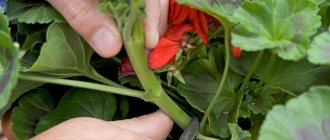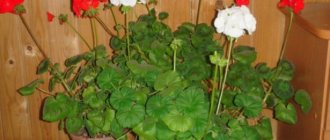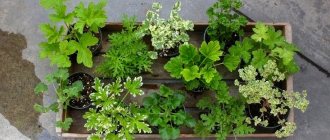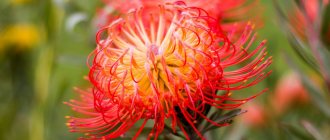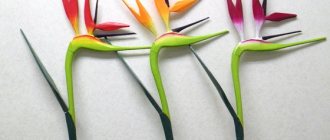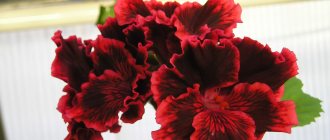Royal geranium is the fruit of many years of painstaking work by breeders. It differs from other similar varieties in its delicate delicate aroma and large size of flowers, which form a cap above the green leaves. It is also known as Grandiflora. This plant looks simply gorgeous; every gardener dreams of having such a luxurious beauty. However, it is worth remembering that large-flowered royal geranium is very capricious and difficult to care for.
This variety of pelargonium has not only an interesting history, but also a number of distinctive features by which it can be easily recognized.
Royal geranium is very difficult to grow, but its chic appearance and delicate delicate aroma compensate for all the inconvenience and costs
It got its name due to its chic appearance during the flowering period. However, in order to achieve the desired result, you need to put in a lot of effort.
What does it look like
The height of an adult plant does not exceed 0.5 m. The flowers are located at the same level as the leaves. The diameter of the inflorescence reaches 15 cm. The color range is very rich: from snow-white to almost black. The most common color palette is red. The upper row of inflorescences is characterized by a more saturated color, sometimes even with a spotted pattern. In appearance, the flower is very similar to a pansy. Particular attention should be paid to the Elegance variety, which is considered the elite. The non-uniform color of the flower cap immediately attracts attention and attracts glances.
Flowers are large in size
The leaves of the royal geranium are velvety, their edges are wavy. Their color is green. The stem is erect. The root system consists of adventitious roots.
Conditions for flowering geraniums and ways to make geraniums bloom
Pelargonium (which many people know as geranium) is a beautiful plant widely used in indoor gardening, as well as for landscaping gardens, balconies and terraces. This flower is loved for its lush and long flowering. Therefore, if your indoor geranium is capricious and does not want to bloom, it means it is missing something. There may be several reasons for this:
- Insufficient lighting. Choose a place for the flower that is bright and warm. If the plant is on a windowsill (next to glass), protect it from direct midday rays. Under the hot scorching sun, pelargonium, of course, blooms, but quickly loses its decorative effect. Therefore, to preserve its beauty, it is better to keep the flower in gentle conditions.
- Incorrect watering. Geranium does not like waterlogging; rather, it prefers a slight drought. Excess moisture leads to rotting of the roots, and even death of the plant. In such conditions, flowering, of course, cannot be expected.
- Wrong pot. Geranium prefers small pots. In a pot that is too spacious, the plant will begin to “fatten”, gaining green and root mass. If you have a large pot or box, plant several plants in it. Let them be a little cramped.
- Irregular feeding. Geranium (pelargonium) is responsive to feeding . With a lack of nutrients, the plant looks lethargic and the leaves turn yellow. Flowering is favorably influenced by potassium and phosphorus fertilizing. If you use a complex fertilizer, its nitrogen content should be no more than 11 percent. Otherwise, the plant will begin to grow only lush greenery. The recommended frequency of fertilizing is once every two weeks with any water-soluble fertilizer.
- Untimely or incorrect pruning. You should not be afraid of large autumn pruning leaving 2-3 eyes, with the exception of royal pelargonium. This only stimulates the plant to grow and bloom in the future. After such severe pruning, it is advisable to leave the flower in a cool room until January. The plant must rest. And then in January the geranium is brought into a warm room. As soon as the plant begins to grow, it needs to be pinched in order to stimulate bushiness.
- Lack of winter rest. Overwintering in a warm room with humid air is a fairly common reason for the lack of flowering or even death of geraniums.
- Damage to the root system. This can happen due to improper watering or improper soil composition. Root rot can also be caused by fungal diseases.
- Pests. Excessive dampness and humidity can provoke fungal diseases such as black rot or root rot . This disease is very difficult to cope with. Therefore, experts recommend destroying infected specimens to avoid infecting neighboring flowers. If you have one geranium flower, you can try to treat the plant with fungicides. The most common pests are whiteflies, aphids, and spider mites. With the help of special means they are successfully destroyed.
Signs and causes of geranium diseases
Signs of the disease Possible causes Necessary measures
| Leaves turn yellow and fall off | Insufficient watering, dry air in the room, proximity to the battery | Move the flower away from the battery, do not allow it to dry out. |
| Blackening of the stem | Blackleg disease | Transplantation with soil sterilization, in some cases destruction of the plant |
| Yellowing of the lower leaves, rotting of the stem | Poor drainage in the pot, overwatering | Washing the roots and removing rotten roots, replanting the plant, reducing watering |
| The appearance of small insects on the lower part of the leaves, drying of the leaves | Weevil, aphid | Treating soil and leaves with fungicide |
| Redness of leaf edges | Too much sun | Shade the plant or move it to another place |
| The appearance of gray mold | Infection with the fungus Botrytis | Removing affected parts of the plant, treating with fungicide |
| Gray coating on leaves | Bacterial or fungal infection | Transplantation, soil sterilization |
Source: https://divo-dacha.ru/komnatnye-rasteniya/pochemu-ne-cvetet-komnatnaya-geran-prichiny-i-usloviya-cveteniya/
Royal geranium care for beginners
Royal geranium - conditions for flowering
A very capricious plant is the royal geranium. Proper care at home for beginners is a big problem. The plant needs special care, so you should familiarize yourself with all the rules and nuances in advance.
Royal pelargonium is capricious in care
Temperature
Royal pelargonium is a heat-loving plant species. In summer, in the climate of the middle zone, it can be kept outdoors at +22-27°C. If this indicator increases, you should water the flower twice a day. The first time this is done before 10 a.m., the second time after 6 p.m.
In winter, the air temperature in the room where royal geranium grows should be maintained at 10-15°C. You can take the pot to a heated loggia or to a greenhouse, but the amount of light should not decrease. A cool window sill with a wooden frame is also suitable for the plant.
Lighting
Geranium loves good lighting, but at the same time requires protection from direct sunlight. With a lack of light, the flower stems become elongated and the leaves become pale in color. It is best to place royal pelargonium on an eastern or western windowsill. If you grow it on a south-facing window, you need to take care of a little shading.
Well-lit places are suitable for growing geraniums.
Watering
Irrigation rates are adjusted depending on temperature and time of year. In summer, when the weather is dry and hot, geraniums are watered 2 times a day. If the flower is kept in a room, then irrigating it 1-2 times a week is enough. In winter, the plant should be watered once a week. Before carrying out the procedure, inspect the earthen lump and make sure that it has had time to dry out.
Attention! If overwatered, royal geranium begins to suffer from powdery mildew and root rot.
Spraying
Spraying of geraniums is carried out only if the air in the room is dry or the central heating radiators are running. You should not be overzealous with this procedure, otherwise fungal diseases may develop.
Humidity
Royal geranium prefers high humidity conditions for growing, but this indicator directly depends on the air temperature in the room.
Priming
You can buy soil for growing royal geranium at a flower shop or prepare it yourself. Its acidity should be neutral, and the composition includes moisture-retaining components (for example, sphagnum).
Royal geranium prefers slightly alkaline soil with a neutral acidity level.
Attention! If the soil is dense, then before planting the flower it is enriched with perlite.
The soil for pelargoniums should be loose and contain a sufficient amount of nutrients. You can prepare it by mixing the following ingredients:
- leaf humus;
- peat;
- sand;
- a small amount of wood ash.
Feeding
Royal pelargonium is grown in cramped pots, so the plant can survive without replanting for several years. Over time, the soil becomes depleted and must be fertilized. In early spring it is worth feeding with a high nitrogen content. With the beginning of flowering, priority is given to phosphorus. To achieve lush flowering, start feeding geraniums in March and stop in September.
Attention! Abuse of fertilizing in winter negatively affects the flowering of royal pelargonium.
Excessive use of fertilizers can harm geraniums
Care in winter, during the dormant period
Winter is a dormant period for geraniums. As soon as the plant has had time to bloom, it should be removed to a cool place with a temperature of 10-14°C, and the amount of watering should be reduced to a minimum. No feeding is needed at this time.
Attention! To ensure more luxuriant color next season, geraniums should be pruned before the dormant period begins.
During the pruning process, the main stem is shortened by a third, and all dry or damaged shoots and leaves are removed. Shoots that appear in winter are pinched.
When does it bloom?
Although royal pelargonium is distinguished by its lush and unique flowering, its timing is very modest. For example, ordinary pelargonium blooms in early spring and fades in late autumn . The royal one pleases the eye only 3-4 months a year. Approximate flowering time is April-August.
The pet is quite capricious and, if not properly cared for, may not bloom at all. To avoid troubles, before purchasing, you should carefully study this species (read about what varieties of this type of pelargonium there are here).
When and how does it bloom
Royal begonia (Begonia Rex) at home
The flowering of royal geranium causes true delight among gardeners. She can not only look great, but also exude an amazingly subtle aroma.
Types of flowers
Royal geranium flowers can be not only classic, but also double. There are even specimens with corrugated inflorescences. The variety of their colors is simply amazing. The following shades can be presented:
- yellow;
- pink;
- red;
- violet;
- orange;
- white.
Royal geraniums have a rich range of colors
Flower shapes
The royal flower mostly has flat and concave petals on the inflorescences, but in some varieties they are wavy. This makes the plants even more attractive and sophisticated.
Flowering period
Unlike other varieties, royal geraniums do not have such a long flowering period. Its duration does not exceed six months. The beginning of flowering coincides with the onset of spring.
How to make it bloom at home
In order for royal geranium to bloom at home, its pot must be a little cramped. The plant also needs a period of rest. Otherwise, it will weaken and will not drown in flowers in the next season. Timely application of fertilizers, normalized watering and sufficient lighting levels are also necessary conditions for flowering.
Pruning for lush flowering
Before the onset of the dormant period, the main stem of royal geranium is shortened by a third of its length. This helps maintain the decorative appearance of the flower and also improves air circulation, which prevents the spread of fungi and pests.
Mandatory pruning is required for lush flowering.
In spring, only thin and non-viable shoots are pruned so that the flower does not waste energy on them. This is done in such a way that at least 4 internodes remain on the shoot. You can also form a standard from the plant, but in this case the fragile stem will have to be attached to a support.
Pruning for lush flowering
The spectacular appearance of pelargonium can be maintained by using the following shaping techniques and pruning for lush flowering. The benefit of this operation is not only the formation of an attractive compact bush shape, but also lush flowering. To obtain such a result, work must begin after the end of the mass flowering process, following the recommendations of experienced flower growers. Because often incorrect pruning leads to plants growing very long stems and losing their decorative appeal. Forming a crown requires a number of simple rules:
- When pruning, take into account the genetic characteristics of the crop.
- Carry out the procedure using a sharp knife or pruning shears, having previously disinfected the tools.
- Pinching should only be done with clean hands.
- Treat cut areas using ground cinnamon or crushed charcoal.
- Stems growing inside the flower should be completely removed. They can be used as cuttings for planting plants.
It is not recommended to prune when geraniums are blooming. Late autumn, as well as early winter, is considered a favorable period for crown formation.
Trimming order
There is a certain procedure for pruning the crop, since incorrect actions can provoke infection in the flower. To do this you should:
- remove wilted shoots and faded inflorescences;
- rid the plant of dried and wilting foliage;
- examine the pelargonium and correctly determine which shoots need to be pruned to form a beautiful crown;
- free the bush from bare and long stems;
- Before wintering, cut off a third of the main stem.
The operation must be carried out with caution, since one-time removal of a large number of shoots can significantly weaken the plant.
Autumn pruning
Indoor geranium is characterized by rapid growth, so after flowering ends, you need to form a bush by pruning and pinching shoots. Autumn pruning is the most favorable and necessary, since after it pelargonium readily forms new shoots, which need to be pinched at the stage of opening 3-5 large leaves on the stems.
How does royal geranium propagate?
There are several proven methods for propagating royal geraniums, which are actively used by experienced flower growers and breeders.
Germination of seeds
Germinating seeds takes longer than just rooting a cutting. But the grown plants will be healthy and strong, and their flowering period will be longer.
Attention! It is impossible to prepare royal geranium seeds yourself, since each variety is a hybrid and, after germination, does not retain the characteristics of the mother plant.
Seed material can be purchased from a reliable and trusted flower shop. The seeds are carefully distributed over moist soil (which necessarily includes sand and perlite), sprinkled with sand on top and slightly buried. The vessel is covered with cellophane or glass and placed in a warm, well-lit place. Direct sunlight on crops is unacceptable. When real leaves appear on the young geranium, it is planted in separate pots. After the fifth true leaf is formed, the plant is pinched.
Rooting cuttings
To propagate by cuttings, use the upper sprouts, the length of which is about 8 cm. Each of them must have at least 2 internodes. Within a couple of hours after pruning, they are allowed to dry and planted in prepared soil, having previously been treated with any root formation stimulator. The cutting is buried 2 cm and placed in a room with a temperature of about +18°C and not very bright lighting.
Attention! To prevent the cuttings from rotting, water them through a tray.
It is best to propagate geraniums from cuttings
Geranium takes root within a week, after which you can plant it in separate pots.
Air layering
This method of propagation is very similar to rooting cuttings. Next to the pot of royal geranium, another container with nutritious soil mixture is placed. Select a suitable strong branch and bend it to the installed container, after which it is fixed with a metal bracket and sprinkled with soil. The soil is tamped down a little and watered. After a week, roots should form. When the new plant begins to develop independently, it is cut off from the mother bush and planted in its own pot.
Attention! It is not recommended to use a cheap Chinese pot for growing royal geraniums, since in it the plant is more often susceptible to disease.
If the royal pelargonium does not bloom
All about garden and landscape design
- All categories
- General information 236
- Rock garden, rock garden 14
- Pool 17
- Gazebo, pergola 20
- Vertical gardening 28
- Reservoirs, fountains, drainage 57
- Lawn, rolled lawn 35
- Grill, barbecue 20
- Soil, peat, fertilizers 11
- Decorative bushes, trees 34
- Paths, platforms, bridges 48
- Plant protection 35
- Earthworks 7
- Tools, inventory 6
- Stone, sawdust, mulch 10
- Fastenings, accessories 2
- Landscape design 159
- Fences, fences 31
- Support structures 5
- Lighting 12
- Fruit bushes, trees 31
- Watering, pumps 18
- Garden design 33
- Garden furniture 18
- Garden equipment 7
- Garden decor 66
- Gardens and parks 319
- Succulents and cacti 11
- Greenhouse, greenhouse 12
- Terraces 0
- Coniferous bushes, trees 9
- Flower garden, flower bed 50
- Flowers, plants 185
Royal pelargonium is a beautiful indoor plant, which, unfortunately, not only has an aristocratic name, but also a character. She is considered a truly royal person among pelargoniums, so sometimes problems can arise with her breeding. For example, the owner cannot achieve good flowering of pelargonium. How to fix the situation?
The plant lays buds for future flowers in autumn and winter, so it is important to create comfortable conditions for pelargonium during this period. It is best to limit watering and also place it in a room with a temperature of up to 13-15 degrees to provide it with a comfortable “rest”. If pelargonium does not bloom, this is most often a consequence of its “overwork” or discomfort.
Pot for pelargonium
Like all geraniums, royal pelargonium blooms well in a tight container. That is why it is worth replanting only when the roots have developed so much that they look out from the drainage hole of the pot. But even in this case, the new dishes should be only slightly larger than the old ones (about one and a half centimeters in diameter). While the plant is still young, every spring it needs to renew the top layer of soil without completely replanting the flower.
Watering royal pelargonium
This plant does not like dense soil and excessive moisture. It is best to water it through a tray, with water that has been settled in advance, and its temperature should be no lower than 20 and no higher than 22 degrees. In summer, the soil should always be slightly moist, and in winter, watering should be reduced to 2-3 times a month.
Fertilizers for pelargonium should not contain large amounts of nitrogen, as it produces a lot of greenery. But potassium in the fertilizer, on the contrary, is responsible for the abundant flowering of pelargonium. If the product is chosen correctly, the plant will feel great and produce a lot of buds.
Pruning royal pelargonium
You need to trim the flower once during the year, either in the fall or at the very beginning of spring (from late February to mid-March). The procedure is divided into several stages. All branches of pelargonium must be divided into three or four identical parts. The first one must be cut at the bottom, between the wood and green zones of the trunk. After this, you need to wait about two weeks until the buds begin to grow on the cut ends. Then you should cut the second part in the same way and again wait for the start of growth and bud formation. Now you can begin to complete it by doing the same manipulations with the remaining parts. If you prune the entire plant at the same time, it will experience enormous stress and its strength may not be enough for full growth and flowering. The step-by-step process helps avoid such problems by allowing young branches to develop.
Transfer
For several years, royal geranium can grow quietly in one pot. In addition, it is painful to transplant into open ground in the summer, unlike other varieties. The procedure is carried out only when the root system has completely filled the planting container. The new pot should be 1.5 cm larger than the previous one. A pot that is too large will slow down the growth of the flower and cause a prolonged absence of flowering.
Attention! Due to frequent transplants and changes in location, royal pelargonium may die.
Royal geranium does not tolerate frequent transplants
It is better to plan geranium transplantation work for the period from February to April. Having emerged from the dormant period, the plant takes root well and enters the active growth phase. In summer and winter, unless absolutely necessary, you should not disturb the flower.
Causes of insufficient flowering
There may be several reasons why geraniums do not grow and there are no flowers.:
- For lush flowering, the plant requires feeding with nutritional compounds high in potassium and phosphorus. Pelargonium is indifferent to organic matter.
- Excessive soil moisture. Pelargonium does not tolerate heavy watering and standing water. If the soil is dry, this has virtually no negative effect on the condition of the green mass and delicate flowers. Geranium does not bloom due to improper watering regime.
- Disproportion in the ratio of the size of the bush and the mass of the earthen ball in which the flower is planted. If there is a lot of land, then pelargonium tries to put down strong roots rather than develop a flower crown. For small plants, the best solution is to place several neighbors in one container with soil. Then the plants will interact, quickly forming a root system, and begin flowering together.
- Preventative pruning in spring and autumn increases the likelihood of lush summer flowering.
- The northwestern and northern sides of the home are the worst places for growing pelargonium. There the plant misses the sun and will not bloom; it may get sick and lose its leaves. Poor lighting is one of the main reasons why geraniums do not bloom.
- By winter, the plant adjusts to dormancy. It needs special conditions - no drafts, coolness, a little moisture and five-hour lighting throughout the winter day.
Possible problems in growing
Even the most experienced gardeners are not one hundred percent protected from the problems that arise when growing royal geraniums. It's even more difficult for beginners.
Drops buds and leaves
If the leaves and buds of the royal geranium begin to fall off, then with a high probability we can say that the room is too hot and the air is very dry. Also, these symptoms sometimes indicate insufficient lighting. You will need to turn on the phytolamp, install a humidifier and take measures to reduce the temperature in the room. If the house is cool, then it is enough to limit yourself to additional lighting and monitor the humidity.
Due to the heat, the royal geranium sheds its leaves and buds
The leaves are turning pale
A change in the color of the leaf blade is provoked not only by a deficiency of microelements (in particular nitrogen), but also by a lack of light, as well as excess moisture. It is urgent to analyze these factors and eliminate the cause.
The tips of the leaves are drying out
This problem in royal geranium most often occurs due to moisture deficiency. You should increase the number of waterings and resort to air humidification, but you should not be too zealous.
The lower leaves fall off
The fact that the lower leaves begin to turn yellow and fall off is caused by both a lack of moisture or nutrients in the soil, as well as a lack of light and poor ventilation of the bush. This symptom also signals rotting of the root system, which can lead to the death of the flower.
Pests
The most dangerous pests for royal geraniums are:
- mite;
- weevils;
- whitefly;
- aphid.
Royal geranium is susceptible to pests
To get rid of parasites, you should wipe the inside of the leaf blade with chamomile infusion and leave the plant for a couple of hours, then rinse everything off. If such actions do not bring a positive result, use an insecticide. Step-by-step instructions for its use are contained in the attached documentation.
Other problems
Sometimes the trunk of the royal geranium begins to rot. This indicates that the plant is affected by blackleg. The development of this disease is caused by excessive watering or low temperatures. Sick plants need to be disposed of and the pot disinfected.
Sometimes gardeners wonder why geraniums are green but lethargic? First of all, you should immediately reduce watering. Otherwise, the flower will bleat with gray rot. The scarlet tint of the leaves indicates low temperatures or the presence of drafts.
Growing Tips
If the geranium does not bloom, what to do with the sloth - folk experience knows:
- Merciless haircut "to zero". You will have to leave a couple of eyes, from which a new crown will grow and form next season. The best time for such a procedure is the beginning of spring.
- For the winter, we send lazy geraniums to a cold balcony and do not provide food until spring.
If pelargonium decides to bloom and produces the first few buds, then it is not recommended to change the location of the container with the plant or even turn the bush with a different side towards the sun - the geranium will immediately shed its flowers.
The watering regime for flowering pelargonium is simple. On hot sunny days, you need to water daily, as soon as the top layer of soil has dried. On cloudy, cool days, watering once a week is sufficient.
The plant will definitely signal an excess of water in the pot - the green leaves will wither, the trunk and branches will become covered with a gray coating. Moreover, the plant can easily die.
At the first signs of wilting, immediately stop watering.
The state of “rest” occurs in a plant that is cool and the air temperature does not exceed 15 degrees Celsius. Pelargonium slows down the growth and swelling of buds and practically stops blooming. Winter time justifies this behavior of a house flower - it gains strength for spring awakening and summer flowering. In summer, geraniums are placed in a well-lit place.
Features of propagating geraniums at home
Gardeners are divided on the best time to propagate the plant. It all depends on the chosen method. Experts agree on one thing: the best period is spring or autumn.
Composition of geranium varieties
Note! For pelargonium, the most favorable time for cuttings is in the fall (late August - early September). This is due to the fact that pruning the plant after flowering gives good strong cuttings
If the purpose of breeding geraniums is rapid flowering, then propagation should begin in March. Then already in July it will be possible to get lush buds on a young flower. The survival rate of spring plantings is 90%. It is more correct to start pruning the cuttings in September, then the flower will grow and develop intensively, and flowering will occur the next year. The survival rate of the planting during this period is 80-90%.
The most unfavorable propagation period for geraniums is mid-summer, in which case the percentage of established plants is minimal. It is optimal to start sowing seeds in March, when there is already enough sunlight. If you plant seeds earlier, the gardener should provide the crops with an additional source of light.
Geranium can be propagated using leaves at any time of the year. The method is relevant in cases where it is impossible to obtain a cutting. Working with royal pelargonium or ampelous (ivy-leaved) pelargonium is more difficult than with regular pelargonium.
Reproduction
Reproduction is carried out by seed, which is completely easy. They mainly use purchased seed, since it can produce quite a lot of seedlings and, moreover, germinates well. But a seed that was collected from geraniums grown by oneself will not be able to provide the desired result, since with this method of propagation, hybrid varieties often lose the characteristics of the mother plant. It is necessary to sow geranium seeds in loose, moistened soil and then cover it with a ball of the same soil or sand, the thickness of which will be about two and a half centimeters. Next, you need to spray water from a spray bottle on top. To avoid the possibility of seedlings becoming infected with blackleg, the soil is washed in advance with a pink solution of potassium permanganate. Then the planting is covered with glass and constantly moistened. The required temperature for seeds to germinate is from 18 to 22 degrees. From the moment the shoots emerge, the glass is removed and the pot is placed in a bright place, while the temperature is lowered to a range of 60 to 20 degrees. After two months, the seedlings begin to form approximately 2-3 leaves. After this, they can be planted in separate pots.
There is also another method of reproduction. In order to carry out this propagation, it is necessary to stock up on cuttings. Their length should be approximately 5 to 7 centimeters. They should also have 2-3 leaves. To implement this method of propagation, you need to wither a fresh cutting for 24 hours and then sprinkle the place where the cutting was cut with crushed coal. Next, it must be planted in a medium pot containing loose soil. When using this propagation method, it is not necessary to cover the cuttings with anything. At the moment when the cuttings take root, they must be transplanted to a permanent habitat. Cuttings can root at air temperatures from 20 to 22 degrees.
Care instructions
Proper watering . In winter, pelargonium is rarely watered; it is enough not to let the soil dry out. In the summer, the procedure becomes more frequent and increases in volume. There is no need to overdo it. Watering using a tray is considered a safe option. This way the roots will never rot, the soil will always be sufficiently moist, and the air humidity around the flower will be optimal.- Feeding . Flowering plants are fertilized with complex mineral supplements. It is recommended to start at the end of February. Once every 3-4 weeks, a mineral solution containing potassium is added. When flowering occurs, fertilizing is carried out more often, once every 14 days.
- Transplant . This is the most important element in caring for pelargonium. It serves to renew the soil and provide suitable containers. The transplant is done in the fall. Royal pelargonium does not tolerate strong winds and scorching sun, so if the gardener decides to put it outside for the summer, then the new pot must be placed in a gazebo, on the veranda or in other protected places.
- Trimming . A procedure that is aimed at balancing the above-ground and underground parts. It is produced after flowering has ended. Side shoots must be removed, but the main ones are only shortened, excess foliage and flower stalks are removed.
The necessary conditions
- Temperature . One of the most important indicators, requirements, which differ depending on the time of year. In winter, the temperature should be within +13 +15 degrees. This will allow the flower to be in a so-called dormant state. When pelargonium begins to actively grow, it should be kept at a temperature of +18..+23 degrees. Extreme heat has a negative effect on your pet. Under no circumstances should drafts be allowed.
- Humidity . The appearance of various types of diseases is often provoked by dry and hot air near heating devices. But excessive humidity is also undesirable. Optimal indicators are from 40% to 60%.
- Lighting . In winter, sunlight becomes much less, which is what pelargonium needs. Short daylight hours with diffused lighting are ideal for the plant. Bright and prolonged rays of the sun can contribute to disruption of biorhythms. At the time of growth and flowering, pelargonium prefers more sun. Stretched shoots and faded foliage are a clear sign of lack of lighting.
- The soil . Royal pelargonium requires fertile and loose soil, with a neutral or slightly acidic reaction. Loamy and clay soil are not suitable. There must be a good drainage layer at the bottom of the pot.
Errors in care and illness
Why doesn’t your favorite geranium bloom at home, but only produce foliage? The main reason is various errors in care. A problem may be uniform watering throughout the year. During active growth, water rarely, but a lot, and do not allow water to stagnate. In winter, lightly moisten the soil so that it has time to dry out between waterings.
Fertilizers are used carefully; geraniums suffer from lack and excess nutrition. Balance is important
Blooming royal geranium needs fresh air and constant ventilation of the room. Fresh air is a prevention against fungal diseases.
The plant is not capricious, but is susceptible to two groups of diseases - non-infectious and infectious:
- If the rules of care are violated, non-infectious diseases appear, the metabolic processes of the plant are disrupted: swelling, hypothermia, lack or excess of microelements, reaction to chemical elements.
- Infectious diseases - rot, infection by virus, fungus, rust, black leg, powdery mildew. They are dangerous because they can be transmitted and infect other flowers. such a plant must be isolated and treated.
The important nuances and rules for propagating royal geraniums by seeds and cuttings, as well as possible problems, are described in a separate material.
Royal geranium is a very beautiful plant. Doesn't get sick often, requires attention 15 minutes a week. If care does not meet the needs of the plant, geranium will quickly signal problems. With careful care, the flower will delight the owner with lush and lush flowering in the spring and summer.
